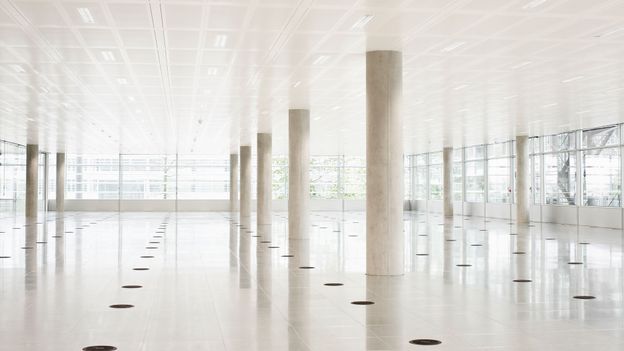As more employees work from home in the hybrid-work era, many companies are finding they need smaller offices. Compared to pre-pandemic floorplans designed to house as many workers as possible, more businesses are looking towards more compact but higher-quality spaces for the future.
According to figures from global commercial real estate firm JLL, 48% of clients in major markets, including the UK, Germany and France are seeking to decrease their footprints in the next three to five years as a result. “Our clients are working out what to do with the space they’ve got by analysing data from recent years to come up with long-term plans,” says Stephanie Hyde, CEO UK and CEO EMEA Markets at JLL. “In addition, many leases are expiring, companies are pressing ahead to meet sustainability agendas and they’re focusing on getting hybrid working right.”
This imminent corporate downsizing is set to have huge ramifications for the real estate industry. As more leases end, experts anticipate a tidal wave of available commercial space on the market. According to March 2024 data from workplace research firm Leesman, total space reductions could reach 40% across its global client base of 766 firms. Projected onto central London, if the same proportion of the city’s occupiers opt to reduce their footprints, this corporate downsize would be the equivalent to 56.6 million sq ft (5.26 million sq m) of office space.
Ah yes, the market. Known for it’s agile flexibilty so that it can adjust to demand at will and efficiently. I’m sure this will turn out well for everyone. By which I mean the peasants will be forced to commute to keep the status quo or they’ll lose their house while governments bail out the class that took on the risk for this real estate.
I think the cat’s out of the bag at this point… There are and will be attempts to reverse the trend by sheer executive will, but it isn’t going to be enough to save the overall commercial real estate market globally.
I don’t know enough about how things are linked together, but I suspect that will have an impact on home prices as well when it happens
My cynical attitude says commercial real estate corporations will probably try to pivot to residential real estate and gouge us all when corporate real estate doesn’t pan out.
TRY to pivot? They already have, that started years ago
I would love to see some hard data on this, but I wonder how much of the increase in corporate purchases of homes is driven by the need to prop up their flagging real estate investments.
The reason prices aren’t dropping with lower demand is that all this shit belongs to hedgefonds, private equity firms and the like. Those fucks are usually leveraged to the hilt, i.e. they cannot cope with even a small correction. That’s why they hold on to high rents at all costs and would rather see a huge increase in vacancies than a drop in rent. That can go on only for so long, until the pressure becomes too great and we’ll have 2008 all over again.
Because their plan A of flooding the public discourse with stories about how we’ll all die if we don’t “return to office” has failed.
I know conversion of office space to apartments is not trivial (location and “bandwidth” of the building’s infrastructure, etc.), but they are buildings that are designed to hold many people for many hours per day, and often occupy some of the best locations for transit and larger parking structures in a given city. At the very least this should result in more residential and mixed-use projects and fewer dedicated office buildings going forward.
From what I understand, you can convert a lot of buildings that were built before the middle of the century; it’s the massive onees that are the issue. Older buildings were designed to let in light and air from the outside. If you break them into apartments, you can get something that’s a reasonable size with windows.
But if you try to convert one of those massive square skyscrapers, you run into issues. You could break each floor into a set of massive apartments, but there aren’t enough people who can afford them. You can make really long, thin apartments with windows at one end, but most people don’t want to live in something that’s 10-15 feet wide, a third of a city block long, with windows at one end. Or you can put the apartments around the edges and then do something with the center space; say, put tenant storage space every 3 floors, a gym every 8 floors, a play area every 5 floors, etc. But that raises the cost of the apartments and incurs monthly fees to clean and maintain those areas.
do something with the center space
A simple shared courtyard on most floors could be valuable, but yeah, it sounds like one of the biggest challenges is making attractive housing out of them. With real estate being somewhat non-fungible though, that becomes a pricing issue. People would live in the high-rise equivalent of a single-wide or container house for free. They wouldn’t for 10 million bucks. Does the inflection point in-between match with the economics of doing the conversion? Every building and every city will have a different calculation.
And yes, there is a nagging sense of boring dystopia going through my brain in all this, though tempered by the sense that we shouldn’t let the perfect be the enemy of the
goodsafely and affordably housed. When do we force Hiro Protagonist to move into his storage unit?
If you made it a co-op with the condition that anyone who buys in early gets an apartment if they help with the refurbishment, you’d probably get a lot of offers.
They mostly wouldn’t be able to do experienced (and more importantly union) contractor work like lay pipe and wire cables, but they could certainly do things like put down carpet and tile and paint walls with a small amount of instruction.
Some of the concerns I’ve seen are that while electrical should be fine for the type of stuff America uses 110v for, overkill even, the plumbing is all in the wrong places and likely inadequate for how many people will need showers and baths, the HVAC isn’t really meant for the granularity people would want, and it would be a challenge to get the ventilation and heavy duty circuitry to every unit to safely allow for cooking.
What I do think they could do is convert to dormitory style housing with shared kitchens and baths, and while that limits your target audience, it limits it to the people most in need of affordable housing. Refurbing existing office blocks is certainly not a panacea, and I am already cringing at some government that thinks it would be, but I don’t think we’re too far off from denser cities considering it in some cases. I think the bigger opportunity is in new builds and more drastic redevelopments. With very few exceptions, I don’t think any urban core needs to be building dedicated office buildings anymore. Seems it would be way easier and sufficiently cost effective to allow for conversion later even if it’s not in the plan now.
But there are too many people with huge sums of money invested to allow a cataclysmic event to happen, and for swathes of cities to become ghost towns. […] vacated commercial buildings are set to be updated, transforming areas formerly packed with office workers during workweeks, and nearly deserted over weekends, into “hybrid destinations” filled with greater green spaces, pedestrianised areas and leisure options that keep a more consistent weekly footfall. […] Developers might be forced to the cliff edge to be creative, but they have around five years to prepare, mobilise and get ready for the future that’s coming.
Lol, this guy imagining that they’re going to spend their time accepting massive losses and making plans to convert their buildings, instead of spending massive amounts of time and money re-writing laws and codes so they don’t get stuck with the losses.
I mean, I could see what he’s saying if this was one city, or some percentage of cities. But this is every city, plus half the suburbs, all at the same time, all trying to offset the same trillions of dollars of losses.
TARPs, you say?
Yeah who would have though employees are unhappy in the hellscape of open Office plans and flexible workplaces. No silence, no privacy, no rest just a constant bussing of all the worker bees around that distract you with questions, loud phone conversations and anything else. But it is much cheaper for the employer so there is that.
No, you don’t understand. Corporations need those open office hellscapes to leverage their protective synergies, to maximize their dynamic paradigms, and to fulfill various other nuggets of marketing buzzword bullshit.
Oh, and because they don’t trust the worker bee employees as far as they can throw them, and because they need to keep the legion of mostly incompetent middle management busy so the C-level muckity-mucks can continue to stiff everyone who works for or uses the company to get fatter bonuses.
(Hmm, I think my cynicism escaped.)
Burn, baby. Burn.
The time spent to commute to work is much longer than the time it takes a hedgie to plummet from a window of their own free will.
Ha haaa
/push











